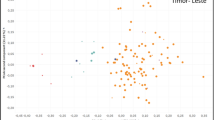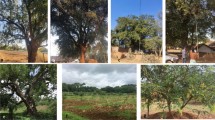Abstract
Germplasm collections of cultivated plants constitute the source for further genetic progress. These collections gained further interest with approaches for tracking allelic variants associated to phenotypic variations within core collections. In order to explore the structure of genetic variation in pepper (Capsicum spp.) and to select core-collections maximizing the genetic and the phenotypic diversity, a pepper collection including 1,352 non redundant accessions from 11 Capsicum species from 89 different countries was genotyped using 28 microsatellite (SSR) markers spanning the whole genome. Model-based analysis structured the collection into 6 clusters, with 3 clusters separating the main species complexes, including cultivated species and wild relatives, according to taxonomic classification (C. frutescens/C. chinense, C. baccatum, C. pubescens), and 3 additional clusters for C. annuum. The relationships between the cultivated C. annuum species and the wild relative (C. annnuum var. glabriusculum) was precised. The 3 C. annuum clusters were significantly distinct for plant and fruit descriptors corresponding to cultivar types, showing that the genetic structure of this cultivated species was strongly impacted by the long term human selection of landraces in primary as well as secondary diversification centres. We settled nested core-collections of 8, 16, 32, 64 and 128 C. annuum accessions capturing from 37 to 90 % of the genetic diversity for further sequencing efforts and establishment of high throughput genotyping assays. By compiling phenotypic and genotypic data, a larger core-collection of 332 accessions was established, capturing 97 % of the C. annuum genetic and phenotypic diversity for further genetic association studies.






Similar content being viewed by others
References
Aguilar-Meléndez A, Morrell PL, Roose ML, Kim SC (2009) Genetic diversity and structure in semiwild and domesticated chili peppers (Capsicum annuum; Solanaceae) from Mexico. Am J Bot 96:1190–1202
Albrecht E, Zhang D, Saftner RA, Stommel JR (2012) Genetic diversity and population structure of Capsicum baccatum genetic resources. Genet Resour Crop Evol 59:517–538
Alimi NA, Bink MCAM, Dieleman JA, Nicolaï M, Wubs M, Heuvelink E, Magan JJ, Voorrips RE, Jansen J, Canas-Rodrigues P, Vercauteren A, Vuylsteke M, Song Y, Glasbey C, Barocsi A, Lefebvre V, Palloix A, van Eeuwijk FA (2013) Genetic and QTL analyses of yield and a set of physiological traits in pepper. Euphytica 190:181–201
Andrews J (1984) Pepper. University of Texas Press, Austin, Texas, The domesticated Capsicum. 163 p
Baral JB, Bosland P (2002) An updated synthesis of the Capsicum genus. Capsicum and Eggplant Newsl 21:11–21
Barchi L, Lefebvre V, Sage-Palloix AM, Lanterri S, Palloix A (2009) QTL analysis of plant development and fruit traits in pepper using selective phenotyping. Theor Appl Genet 118:1157–1171
Bosland PW, Votava EJ (2000) Peppers: vegetable and spice Capsicum. CABI Publishing, Oxon
Djian-Caporalino C, Lefebvre V, Sage-Daubèze AM, Palloix A (2007) Capsicum. In: Singh RJ (ed) Genetic resources, chromosome engineering and crop improvement series, Vol 3, Vegetable crops. CRC Press, Florida (USA), pp 185–243
Evanno G, Regnaut S, Goudet J (2005) Detecting the number of clusters of individuals using the software structure: a simulation study. Mol Ecol 14:2611–2620
FAO (2010) The second report on the state of the world’s plant genetic resources for food and agriculture. Rome, 370 p. http://www.fao.org/docrep/013/i1500e/i1500e00.htm
Ferriol M, Picό B, Nuez F (2003) Genetic diversity of a germplasm collection of Cucurbita pepo using SRAP and AFLP markers. Theor Appl Genet 107:271–282
Freedman ML, Reich D, Penney KL et al (2004) Assessing the impact of population stratification on genetic association studies. Nat Genet 36:388–393
Fulton TM, Chunwongse J, Tanksley SD (1995) Microprep protocol for extraction of DNA from tomato and other herbaceous plants. Plant Mol Biol Rep 13:207–209
González-Jaral P, Moreno-Letelier A, Fraile A, Pinero D, García-Arenal F (2012) Impact of human management on the genetic variation of wild pepper Capsicum annuum var. glabriusculum. PLoS ONE 6(12):e28715. doi:10.1371/journal.pone.0028715
Gouesnard B, Bataillon TM, Decoux G, Rozale C, Schoen DJ, David JL (2001) MSTRAT: an Algorithm for building germplasm core collections by maximizing allelic or phenotypic richness. J Hered 92:93–94
Gupta PK, Rustgi S, Kulwal PL (2005) Linkage disequilibrium and association studies in higher plants: present status and future prospects. Plant Mol Biol 57:461–485
Hammer K, Arrowsmith N, Gladis T (2003) Agrobiodiversity with emphasis on plant genetic resources. Naturwissenschaften 90(6):241–250. doi:10.1007/s00114-003-0433-4
Hernandez-Verdugo S, Luna-Reyes R, Oyama K (2001) Genetic structure and differentiation of wild and domesticated populations of Capsicum annuum (Solanaceae) from Mexico. Plant Syst Evol 226:129–142
Hurtado M, Vilanova S, Plazas M, Gramazio P, Fonseka HH, Fonseka R, Prohens J (2012) Diversity and relationships of eggplants from three geographically distant secondary centers of diversity. PLoS ONE e41748
Ibiza VP, Blanca J, Cañizares J, Nuez F (2012) Taxonomy and genetic diversity of domesticated Capsicum species in the Andean region. Genet Resour Crop Evol 59:1077–1088
Ince AG, Karaca M, Onus AN (2010) Genetic relationships within and between Capsicum species. Biochem Genet 48:83–95
IPGRI, AVRDC, CATIE (1995) Descriptors for Capsicum (Capsicum spp.). International Plant Genetic Resources Institute, Rome, Italy
Jeong HJ, Jo YD, Park SW, Kang BC (2010) Identification of Capsicum species using SNP markers based on high resolution melting analysis. Genome 53:1029–1040
Jing LV, Qi J, Shi Q, Shen D, Zhang S, Shao G, Li H, Sun Z, Weng Y, Shang Y, Gu X, Li X, Zhu X, Zhang J, van Treuren R, van Dooijeweert W, Zhang Z, Huang S (2012) Genetic diversity and population structure of cucumber (Cucumis sativus L.). PLoS ONE 7:e46919
Jung JK, Park SW, Liu WY, Kang BC (2010) Discovery of single nucleotide polymorphism in Capsicum and SNP markers for cultivar identification. Euphytica 175:91–107
Lee JM, Nahm SH, Kim YM, Kim BD (2004) Characterization and molecular genetic mapping of microsatellite loci in pepper. Theor Appl Genet 108:619–627
Lefebvre V, Palloix A, Rives M (1993) Nuclear RFLP between pepper cultivars (Capsicum annuum L.). Euphytica 71:189–199
Lefebvre V, Goffinet B, Chauvet JC, Caromel B, Signoret P, Brand R, Palloix A (2001) Evaluation of genetic distances between pepper inbred lines for cultivar protection purposes: comparison of AFLP, RAPD and phenotypic data. Theor Appl Genet 102:741–750
Liu K, Muse SV (2005) PowerMarker: an integrated analysis environment for genetic marker analysis. Bioinformatics 21:2128–2129
Loaiza-Figueroa F, Ritland K, Laborde Cancino JA, Tanksley SD (1989) Patterns of genetic variation of the genus Capsicum (Solanaceae) in Mexico. Pl Syst Evol 165:159–188
Louarn S, Torp AM, Holme IB, Andersen SB, Jensen BD (2007) Database derived microsatellite markers (SSRs) for cultivar differentiation in Brassica oleracea. Genet Resour Crop Evol 54:1717–1725
Marita JM, Rodriguez JM, Nienhuis J (2000) Development of an algorithm identifying maximally diverse core collections. Genet Resour Crop Evol 47:515–526
Moscone EA, Scaldaferro MA, Grabiele M, Cecchini NM, Garcia YS, Jarret R, Davina JR, Ducasse DA, Barboza GE, Ehrendorfer F (2007) The evolution of chili peppers (Capsicum—Solanaceae): a cytogenetic perspective. In: Proceedings of the VIth international Solanaceae conference. Solanaceae VI: Genomics Meets Biodiversity, Acta Horticulturae 745:137–169
Moses M, Umaharan P (2012) Genetic structure and phylogenetic relationships of Capsicum chinense. J Am Hort Sci 137:250–262
Nagy I, Stàgel A, Sasvári Z, Röder M, Ganal M (2007) Development, characterization, and transferability to other Solanaceae of microsatellite markers in pepper (Capsicum annuum L.). Genome 50:668–688
Nicolaï M, Pisani C, Bouchet JP, Vuylsteke M, Palloix A (2012) Discovery of a large set of SNP and SSR genetic markers by high-throughput sequencing of pepper (Capsicum annuum). Genet Mol Res 11:2295–2300
Nuez F, Gil R, Costa J (1996) El cultivo de pimientos, chiles y ajies. Mundi-Prensa, Madrid
Pacheco-Olvera A, Hernández-Verdugo S, Rocha-Ramírez V, González-Rodríguez A, Oyama K (2012) Genetic diversity and structure of pepper (Capsicum annuum L.) from Northwestern Mexico analyzed by microsatellite markers. Crop Sci 52:231–241
Paran I, Aftergoot E, Shifriss C (1998) Variation in Capsicum annuum revealed by RAPD and AFLP markers. Euphytica 99:167–173
Perrier X, Jacquemoud-Collet JP (2006) DARwin software. http://darwin.cirad.fr/
Pickersgill B (1991) Cytogenetics and evolution of Capsicum L. In: Tsuchiya T, Gupta PK (eds) Chromosome engineering in plants: genetics, breeding, evolution. Elsevier, Amsterdam, pp 139–160
Pickersgill B, Heiser CB, McNeill J (1979) Numerical taxonomic studies of variation and domestication in some species of Capsicum. In: Hawkes JG (ed) The biology and taxonomy of the Solanaceae. Academic Press, New York, pp 679–699
Portis E, Nagy I, Sasvari Z, Stagel A, Barchi L, Lanteri S (2007) The design of Capsicum spp. SSR assays via analysis of in silico DNA sequence, and their potential utility for genetic mapping. Plant Sci 172:640–648
Prince JP, Loaiza-Figueroa F, Tanksley SD (1992) Restriction fragment length polymorphism and genetic distance among Mexican accessions of Capsicum. Genome 35:726–732
Pritchard JK, Stephens M, Rosenberg NA, Donnelly P (2000) Association mapping in structured populations. Am J Hum Genet 67:170–181
Ranc N, Muños S, Santoni S, Causse M (2008) A clarified position for Solanum lycopersicum var. cerasiforme in the evolutionary history of tomatoes (Solanaceae). BMC Plant Biol 8:130. doi:10.1186/1471-2229-8-130
Ranc N, Muños S, Xu J, Le Paslier MC, Chauveau A, Bounon R, Rolland S, Bouchet JP, Brunel D, Causse M (2010) Genome-wide association mapping in tomato (Solanum lycopersicum) is possible using genome admixture of Solanum lycopersicum var. cerasiforme. Genes Genomes Genet 2:853–864
Rodriguez JM, Berke T, Engle L, Nienhuis J (1999) Variation among and within Capsicum species revealed by RAPD markers. Theor Appl Genet 99:147–156
Sage-Palloix AM, Jourdan F, Phaly T, Nemouchi G, Lefebvre V, Palloix A (2007) Structuring genetic diversity in pepper genetic resources: distribution of horticultural and resistance traits in the INRA pepper germplasm. In: Niemirowicz-Szczytt K (ed) Progress in research on Capsicum and eggplant. Warsaw University of Life Sciences Press, Warsaw, Poland, pp 33–42
Simko I (2009) Development of EST-SSR markers for the study of population structure in lettuce (Lactuca sativa L.). J Hered 100:256–262
Somos A (1984) The paprika. Akademiai Kiado, Budapest, ISBN 963 05 3299 9, p 302
Tam SM, Lefebvre V, Palloix A, Sage-Palloix AM, Grandbastien MA (2009) LTR-retrotransposons Tnt1 and T135 markers reveal genetic diversity and evolutionary relationships of domesticated peppers. Theor Appl Genet 119:973–989
Tang H, Sezen U, Paterson AH (2010) Domestication and plant genomes. Curr Opin Plant Biol 13:160–166
Toquica SP, Rodriguez F, Martinez E, Duque MC, Tohme J (2003) Molecular characterization by AFLPs of Capsicum germplasm from the Amazon department in Colombia. Genet Resour Crop Evol 50:639–647
Votava EJ, Nabhan GP, Bosland PW (2002) Genetic diversity and similarity revealed via molecular analysis among and within an in situ population and ex situ accessions of chiltepin (Capsicum annuum var. glabriusculum). Conserv Genet 3:123–129
Walsh BM, Hoot SB (2001) The phylogenetic relationships of Capsicum (Solanaceae) using DNA sequences from two non-coding regions: the chloroplast atpB-rbcL spacer region and nuclear waxy introns. Int J Plant Sci 162:1409–1418
Yi G, Lee JM, Lee S, Choi D, Kim BD (2006) Exploitation of pepper EST–SSRs and an SSR-based linkage map. Theor Appl Genet 114:113–130
Zhu C, Gore M, Buckler ES, Yu J (2008) Status and prospects of association mapping in plants. The Plant Genome 1:5–20
Zwendie Y, Tong N, Bosland P (2004) Establishing a core collection of Capsicum using a cluster analysis with enlightened selection of accessions. Genet Res Crop Evol 51:147–151
Acknowledgments
The authors thank Ghislaine Nemouchi and Bruno Savio for technical help, Charles Poncet as coordinator of the Gentyane PlateForme of INRA-Clermont Ferrand which hosted the genotyping of the accessions, Christopher Sauvage, Nicolas Ranc (INRA-GAFL Avignon) and Marie-Hélène Muller (INRA Montpellier) for discussions and critical review of the manuscript. This work was supported by the SPICY European project (“Smart tools for Prediction and Improvement of Crop Yield”, KBBE-2008-211347).
Author information
Authors and Affiliations
Corresponding author
Electronic supplementary material
Below is the link to the electronic supplementary material.
Rights and permissions
About this article
Cite this article
Nicolaï, M., Cantet, M., Lefebvre, V. et al. Genotyping a large collection of pepper (Capsicum spp.) with SSR loci brings new evidence for the wild origin of cultivated C. annuum and the structuring of genetic diversity by human selection of cultivar types. Genet Resour Crop Evol 60, 2375–2390 (2013). https://doi.org/10.1007/s10722-013-0006-0
Received:
Accepted:
Published:
Issue Date:
DOI: https://doi.org/10.1007/s10722-013-0006-0




